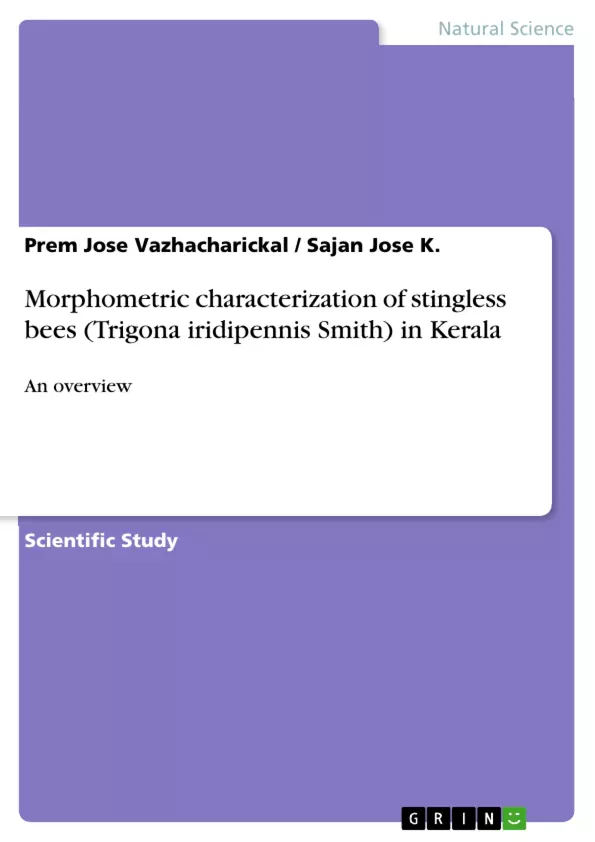The major species of stingless bees in Kerala is Trigona iridipennis Smith which are easy to domesticate due to low temperament and easy adaption to various habitats. Little is known about the variations that exist among them. We therefore conducted morphometric studies among workers and drones across 14 districts in Kerala with a view to characterize them.
A total of 188 and 71 samples of drones and workers collected and analyzed various morphometric characters including head length (HL), head width (HW), proboscis length (PL), distance between two dorsal ocelli/lower intercocular distance (DBO), dorsal ocello-ocular distance (DOOD), antennal length (AL), thorax femur length (TFL), thorax tibia length (TTL), thorax metatarsus length (TML), thorax metatarsus width (TMW), thorax forewing length (TFWL), thorax forewing width (TFWW), pterostigma width (PtStW), pterostigma length (PtStW), hind wing length (HWL), hind wing width (HWW), number of hamuli (HAM), abdominal tergite length (AbTL), abdominal sternum width (AbSW), mandible length (MdL) and mandible width (MdW), head length width ratio (HLW), thorax metatarsus length width ratio (TMLW) and thorax forewing length width ratio (TFWLW).
Our studies revealed that most of the worker morhopometric characters were positively correlated across all the districts in Kerala. However, there is not much significant differences among drones across various districts. Based on our studies, even though we detected significant differences among worker morhphotmetry we could not to find distinguishing and remarkable differences among collected samples. They may be interpreted as nutritional, seasonal and climatic factors.
Table of Contents
- Introduction
- Materials and Methods
- Study area
- Study design and data collection
- Morphometric measurements
- Statistical analysis
- Results
- Descriptive analysis
- Corelation analysis
- Principal component analysis
- Discussion
Objectives and Key Themes
This research aims to characterize the morphometric features of the stingless bee species Trigona iridipennis in Kerala, India. The study seeks to understand the morphological variations within this species across different locations in the region.
- Morphometric characterization of stingless bees
- Spatial variation in morphometric traits
- Application of statistical analysis to understand morphological patterns
- Ecological implications of morphometric variations
- Potential for conservation and management of stingless bees
Chapter Summaries
Introduction
This chapter provides an overview of stingless bees, their importance in pollination, and the significance of morphometric studies. It also outlines the research objectives and the specific bee species under investigation.
Materials and Methods
This chapter details the study area, including the geographic locations where data was collected. It describes the methodology employed for data collection, including the morphometric measurements taken and the statistical analyses used.
Results
This chapter presents the findings of the study, including descriptive statistics, correlations between morphometric traits, and the results of principal component analysis. The results highlight the observed patterns and variations in morphometric features.
Discussion
This chapter discusses the implications of the results, comparing them to existing literature and exploring possible explanations for the observed patterns. It considers the ecological and evolutionary significance of the findings.
Keywords
Stingless bees, Trigona iridipennis, morphometric analysis, Kerala, spatial variation, principal component analysis, pollination, conservation.
- Quote paper
- Prem Jose Vazhacharickal (Author), Sajan Jose K. (Author), 2014, Morphometric characterization of stingless bees (Trigona iridipennis Smith) in Kerala, Munich, GRIN Verlag, https://www.grin.com/document/349834



